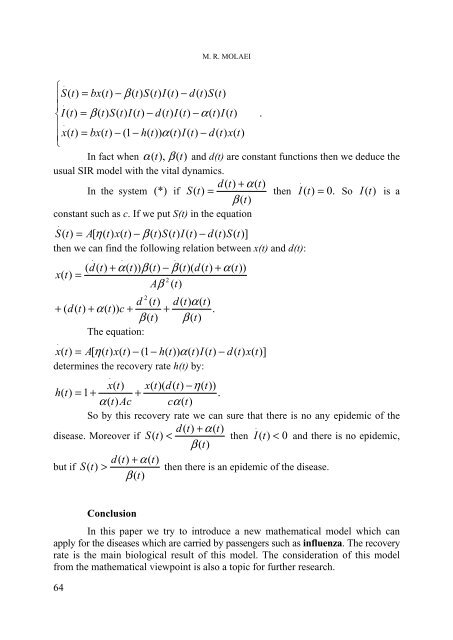biologia - Studia
biologia - Studia
biologia - Studia
You also want an ePaper? Increase the reach of your titles
YUMPU automatically turns print PDFs into web optimized ePapers that Google loves.
M. R. MOLAEI<br />
.<br />
⎧<br />
⎪<br />
S(<br />
t)<br />
= bx(<br />
t)<br />
− β ( t)<br />
S(<br />
t)<br />
I(<br />
t)<br />
− d(<br />
t)<br />
S(<br />
t)<br />
.<br />
⎨I(<br />
t)<br />
= β ( t)<br />
S(<br />
t)<br />
I(<br />
t)<br />
− d(<br />
t)<br />
I(<br />
t)<br />
− α(<br />
t)<br />
I(<br />
t)<br />
.<br />
.<br />
⎪<br />
⎪x(<br />
t)<br />
= bx(<br />
t)<br />
− (1 − h(<br />
t))<br />
α(<br />
t)<br />
I(<br />
t)<br />
− d(<br />
t)<br />
x(<br />
t)<br />
⎩<br />
In fact when α ( t),<br />
β ( t)<br />
and d(t) are constant functions then we deduce the<br />
usual SIR model with the vital dynamics.<br />
d(<br />
t)<br />
+ α(<br />
t)<br />
.<br />
In the system (*) if S(<br />
t)<br />
= then I ( t)<br />
= 0.<br />
So I (t)<br />
is a<br />
β ( t)<br />
constant such as c. If we put S(t) in the equation<br />
.<br />
S(<br />
t)<br />
= A[<br />
η ( t)<br />
x(<br />
t)<br />
− β ( t)<br />
S(<br />
t)<br />
I(<br />
t)<br />
− d(<br />
t)<br />
S(<br />
t)]<br />
then we can find the following relation between x(t) and d(t):<br />
.<br />
.<br />
( d(<br />
t)<br />
+ α ( t))<br />
β ( t)<br />
− β ( t)(<br />
d(<br />
t)<br />
+ α(<br />
t))<br />
x( t)<br />
=<br />
2<br />
Aβ<br />
( t)<br />
2<br />
d ( t)<br />
d(<br />
t)<br />
α(<br />
t)<br />
+ ( d(<br />
t)<br />
+ α ( t))<br />
c + + .<br />
β ( t)<br />
β ( t)<br />
The equation:<br />
.<br />
x(<br />
t)<br />
= A[<br />
η ( t)<br />
x(<br />
t)<br />
− (1 − h(<br />
t))<br />
α(<br />
t)<br />
I(<br />
t)<br />
− d(<br />
t)<br />
x(<br />
t)]<br />
determines the recovery rate h(t) by:<br />
.<br />
.<br />
x(<br />
t)<br />
x(<br />
t)(<br />
d(<br />
t)<br />
−η(<br />
t))<br />
h(<br />
t)<br />
= 1+<br />
+<br />
.<br />
α(<br />
t)<br />
Ac cα<br />
( t)<br />
So by this recovery rate we can sure that there is no any epidemic of the<br />
d(<br />
t)<br />
+ α(<br />
t)<br />
.<br />
disease. Moreover if S(<br />
t)<br />
< then I ( t)<br />
< 0 and there is no epidemic,<br />
β ( t)<br />
d(<br />
t)<br />
+ α(<br />
t)<br />
but if S(<br />
t)<br />
> then there is an epidemic of the disease.<br />
β ( t)<br />
64<br />
Conclusion<br />
In this paper we try to introduce a new mathematical model which can<br />
apply for the diseases which are carried by passengers such as influenza. The recovery<br />
rate is the main biological result of this model. The consideration of this model<br />
from the mathematical viewpoint is also a topic for further research.
















